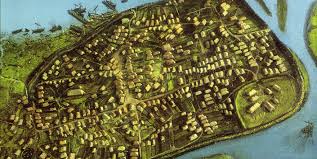Your basket is currently empty!
138 – Death of Roman Emperor Hadrian

On July 10, 138, Roman Emperor Hadrian passed away at his villa in Baiae, Italy, marking the end of a sixteen-year reign . Known for consolidating and fortifying the Roman Empire, Hadrian traveled extensively throughout his realm. He commissioned major constructions like Hadrian’s Wall in Britain and rebuilt the Pantheon in Rome. His death led to the accession of Antoninus Pius, marking a peaceful transition of power. Hadrian’s legacy endures in his architectural projects and cultural contributions. He is remembered as one of Rome’s “Five Good Emperors.” His reign prioritized stability, culture, and infrastructure over conquest. Today, Hadrian is still celebrated for shaping the Roman Empire’s historical identity.
988 – Founding of the City of Dublin

On July 10, 988, the Norse King Glúniairn recognized the Irish High King Máel Sechnaill mac Domnaill, formalizing Dublin’s founding and its integration into a broader medieval kingdom . Initially established as a Viking settlement, it became an important trading port in Ireland. The city’s name, Dubh Linn, means “black pool” in Irish, referencing a local lake. With the treaty, Viking Dublin gained legal status and protection under Irish law. This agreement paved the way for deeper cultural and economic integration. Dublin grew over centuries into Ireland’s political and cultural heart. Today, it’s recognized globally as the nation’s capital and cultural hub. July 10 represents a milestone in the development of a major European city.
1540 – Henry VIII Annuls His Marriage to Anne of Cleves

On July 10, 1540, King Henry VIII of England officially annulled his fourth marriage to Anne of Cleves, citing lack of consummation and political misalignment. This abrupt annulment was orchestrated by Henry’s chief minister, Thomas Cromwell, who aimed to strengthen alliances with Protestant German states. The failure of this marriage damaged Cromwell’s reputation and eventually led to his execution. Politically, it underscored the unstable nature of Henry’s matrimonial alliances. Despite the annulment, Anne was treated with dignity and granted the title “The King’s Beloved Sister.” Her retention at court marked a rare example of royal mercy. The event highlights the volatile mix of politics and marriage in Tudor England. Today, it remains one of the most dramatic twists in royal history.
1645 – Parliamentarian Victory at the Battle of Langport

On July 10, 1645, during the First English Civil War, the New Model Army under Sir Thomas Fairfax decisively defeated Royalist forces at Langport in Somerset, England. This battle followed the earlier Parliamentarian victory at Naseby and helped solidify control over southwestern England. Fairfax’s disciplined troops overran Lord Goring’s army, capturing key artillery and inflicting heavy losses. The Royalist field force was effectively neutralized, enabling further Parliamentarian advances. Langport served as a catalyst for the eventual surrender of Bristol and other strongholds. The battle demonstrated the power of disciplined infantry and strategic maneuvering. It highlighted the effectiveness of the New Model Army as the backbone of Parliament’s success. July 10 remains a key date in Civil War history and military evolution.
1890 – Wyoming Becomes the 44th U.S. State and Grants Women’s Suffrage

On July 10, 1890, Wyoming was admitted to the Union as the 44th U.S. state and reaffirmed its 1869 law granting women the right to vote. This made Wyoming the first state to enforce equal suffrage for all adult women. The law was enacted to attract more settlers to the sparsely populated territory. It also set a groundbreaking precedent for women’s rights across America. The new state constitution encouraged political and social equality. Wyoming’s bold move inspired suffrage efforts in other states. Today, July 10 remains celebrated as Wyoming Day—a landmark in women’s voting rights. Wyoming’s legacy is still invoked in modern debates on equality.
1985 – Greenpeace Ship Rainbow Warrior Sunk by French Operatives

On July 10, 1985, the Greenpeace ship Rainbow Warrior was bombed and sunk in Auckland Harbor, New Zealand, by French intelligence agents. The attack, which killed photographer Fernando Pereira, sparked international scandal and outrage. France admitted responsibility months later, causing a diplomatic crisis with New Zealand. The incident highlighted tensions over French nuclear testing in the Pacific. It galvanized global environmental activism and respect for Greenpeace’s work. New Zealand’s firm response and investigation won global praise. The sinking became a symbol of state-sponsored suppression of environmental protest. Today, the Rainbow Warrior is remembered as both a tragedy and a triumph for environmental justice.
Want to dive deeper into ancient warfare? Don’t miss our articles on Timeline Stories.

